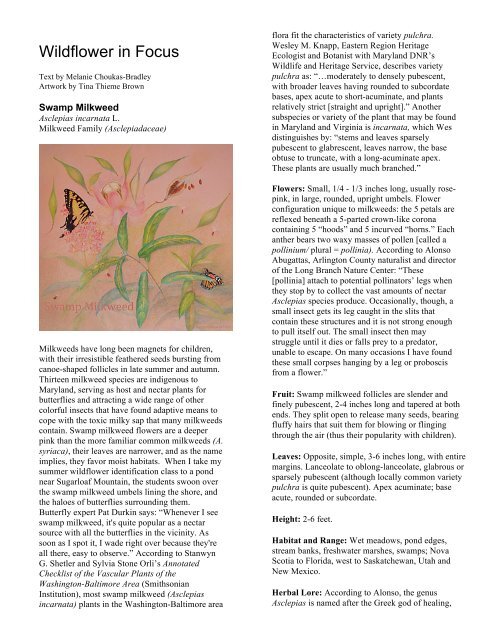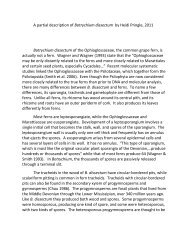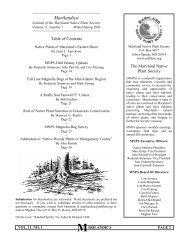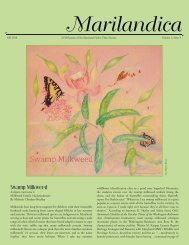Wildflower in Focus - Maryland Native Plant Society
Wildflower in Focus - Maryland Native Plant Society
Wildflower in Focus - Maryland Native Plant Society
Create successful ePaper yourself
Turn your PDF publications into a flip-book with our unique Google optimized e-Paper software.
<strong>Wildflower</strong> <strong>in</strong> <strong>Focus</strong><br />
Text by Melanie Choukas-Bradley<br />
Artwork by T<strong>in</strong>a Thieme Brown<br />
Swamp Milkweed<br />
Asclepias <strong>in</strong>carnata L.<br />
Milkweed Family (Asclepiadaceae)<br />
Milkweeds have long been magnets for children,<br />
with their irresistible feathered seeds burst<strong>in</strong>g from<br />
canoe-shaped follicles <strong>in</strong> late summer and autumn.<br />
Thirteen milkweed species are <strong>in</strong>digenous to<br />
<strong>Maryland</strong>, serv<strong>in</strong>g as host and nectar plants for<br />
butterflies and attract<strong>in</strong>g a wide range of other<br />
colorful <strong>in</strong>sects that have found adaptive means to<br />
cope with the toxic milky sap that many milkweeds<br />
conta<strong>in</strong>. Swamp milkweed flowers are a deeper<br />
p<strong>in</strong>k than the more familiar common milkweeds (A.<br />
syriaca), their leaves are narrower, and as the name<br />
implies, they favor moist habitats. When I take my<br />
summer wildflower identification class to a pond<br />
near Sugarloaf Mounta<strong>in</strong>, the students swoon over<br />
the swamp milkweed umbels l<strong>in</strong><strong>in</strong>g the shore, and<br />
the haloes of butterflies surround<strong>in</strong>g them.<br />
Butterfly expert Pat Durk<strong>in</strong> says: “Whenever I see<br />
swamp milkweed, it's quite popular as a nectar<br />
source with all the butterflies <strong>in</strong> the vic<strong>in</strong>ity. As<br />
soon as I spot it, I wade right over because they're<br />
all there, easy to observe.” Accord<strong>in</strong>g to Stanwyn<br />
G. Shetler and Sylvia Stone Orli’s Annotated<br />
Checklist of the Vascular <strong>Plant</strong>s of the<br />
Wash<strong>in</strong>gton-Baltimore Area (Smithsonian<br />
Institution), most swamp milkweed (Asclepias<br />
<strong>in</strong>carnata) plants <strong>in</strong> the Wash<strong>in</strong>gton-Baltimore area<br />
flora fit the characteristics of variety pulchra.<br />
Wesley M. Knapp, Eastern Region Heritage<br />
Ecologist and Botanist with <strong>Maryland</strong> DNR’s<br />
Wildlife and Heritage Service, describes variety<br />
pulchra as: “…moderately to densely pubescent,<br />
with broader leaves hav<strong>in</strong>g rounded to subcordate<br />
bases, apex acute to short-acum<strong>in</strong>ate, and plants<br />
relatively strict [straight and upright].” Another<br />
subspecies or variety of the plant that may be found<br />
<strong>in</strong> <strong>Maryland</strong> and Virg<strong>in</strong>ia is <strong>in</strong>carnata, which Wes<br />
dist<strong>in</strong>guishes by: “stems and leaves sparsely<br />
pubescent to glabrescent, leaves narrow, the base<br />
obtuse to truncate, with a long-acum<strong>in</strong>ate apex.<br />
These plants are usually much branched.”<br />
Flowers: Small, 1/4 - 1/3 <strong>in</strong>ches long, usually rosep<strong>in</strong>k,<br />
<strong>in</strong> large, rounded, upright umbels. Flower<br />
configuration unique to milkweeds: the 5 petals are<br />
reflexed beneath a 5-parted crown-like corona<br />
conta<strong>in</strong><strong>in</strong>g 5 “hoods” and 5 <strong>in</strong>curved “horns.” Each<br />
anther bears two waxy masses of pollen [called a<br />
poll<strong>in</strong>ium/ plural = poll<strong>in</strong>ia). Accord<strong>in</strong>g to Alonso<br />
Abugattas, Arl<strong>in</strong>gton County naturalist and director<br />
of the Long Branch Nature Center: “These<br />
[poll<strong>in</strong>ia] attach to potential poll<strong>in</strong>ators’ legs when<br />
they stop by to collect the vast amounts of nectar<br />
Asclepias species produce. Occasionally, though, a<br />
small <strong>in</strong>sect gets its leg caught <strong>in</strong> the slits that<br />
conta<strong>in</strong> these structures and it is not strong enough<br />
to pull itself out. The small <strong>in</strong>sect then may<br />
struggle until it dies or falls prey to a predator,<br />
unable to escape. On many occasions I have found<br />
these small corpses hang<strong>in</strong>g by a leg or proboscis<br />
from a flower.”<br />
Fruit: Swamp milkweed follicles are slender and<br />
f<strong>in</strong>ely pubescent, 2-4 <strong>in</strong>ches long and tapered at both<br />
ends. They split open to release many seeds, bear<strong>in</strong>g<br />
fluffy hairs that suit them for blow<strong>in</strong>g or fl<strong>in</strong>g<strong>in</strong>g<br />
through the air (thus their popularity with children).<br />
Leaves: Opposite, simple, 3-6 <strong>in</strong>ches long, with entire<br />
marg<strong>in</strong>s. Lanceolate to oblong-lanceolate, glabrous or<br />
sparsely pubescent (although locally common variety<br />
pulchra is quite pubescent). Apex acum<strong>in</strong>ate; base<br />
acute, rounded or subcordate.<br />
Height: 2-6 feet.<br />
Habitat and Range: Wet meadows, pond edges,<br />
stream banks, freshwater marshes, swamps; Nova<br />
Scotia to Florida, west to Saskatchewan, Utah and<br />
New Mexico.<br />
Herbal Lore: Accord<strong>in</strong>g to Alonso, the genus<br />
Asclepias is named after the Greek god of heal<strong>in</strong>g,
eflect<strong>in</strong>g the traditional medical uses of milkweeds.<br />
Steven Foster and James A. Duke (Peterson Field<br />
Guides: Eastern/Central Medic<strong>in</strong>al <strong>Plant</strong>s) report:<br />
Swamp milkweed “root tea [is] diuretic, carm<strong>in</strong>ative,<br />
strongly laxative; <strong>in</strong>duces vomit<strong>in</strong>g. American<br />
colonists used it for asthma, rheumatism, syphilis,<br />
worms, and as a heart tonic. Warn<strong>in</strong>g: Potentially<br />
toxic.” <strong>Maryland</strong> <strong>Native</strong> <strong>Plant</strong> <strong>Society</strong> board member,<br />
master gardener and weed warrior Marney Bruce<br />
(founder of Simplicity Matters Earth Institute) says<br />
that author Timothy Coffey “writes that Pueblo<br />
Indians cut it down when ripe, rub it so as to separate<br />
the fibers, and make of it beautiful and very strong<br />
fish<strong>in</strong>g l<strong>in</strong>es and f<strong>in</strong>e sew<strong>in</strong>g-thread. He notes that<br />
early botanists remarked at how tough and strong the<br />
stem is.” When I queried a few members and friends<br />
of the <strong>Maryland</strong> <strong>Native</strong> <strong>Plant</strong> <strong>Society</strong> about swamp<br />
milkweed and milkweeds <strong>in</strong> general I discovered a<br />
wide-spread and deep fasc<strong>in</strong>ation for this genus. Dr.<br />
Edward M. Barrows, biology professor at Georgetown<br />
University and director of the Georgetown University<br />
Center for the Environment, shared many wonderful<br />
milkweed stories and this is my favorite: “When I was<br />
on Oahu, Hawaii <strong>in</strong> 1976 dur<strong>in</strong>g a lovely November<br />
day with an ocean breeze, I was amazed to see giant<br />
milkweed shoots which were about 10 feet tall<br />
grow<strong>in</strong>g <strong>in</strong> a garden.” Dr. Barrows noted: “This plant<br />
might have been Calotropis procera=Asclepias<br />
procera, Giant Milkweed, native to West Africa<br />
through India.” He went on to say: “I had to rub my<br />
eyes to make sure I wasn’t dream<strong>in</strong>g <strong>in</strong> Rousseau<br />
Land…The plants looked like giant, mutant Asclepias<br />
syriaca to me, and it seemed like the Mean Giant<br />
might descend on them at any moment look<strong>in</strong>g for<br />
children to eat. I saw normal-sized Monarchs nectar<strong>in</strong>g<br />
on the flowers. Both species are aliens on Oahu—a<br />
poor, hapless island under water <strong>in</strong> aliens.”<br />
Similar Species: More than a dozen milkweeds are<br />
<strong>in</strong>digenous to <strong>Maryland</strong>. Deep rose-p<strong>in</strong>k corollas<br />
and moist habitats are the best means of separat<strong>in</strong>g<br />
swamp milkweed plants from other locally<br />
<strong>in</strong>digenous species.<br />
Bloom<strong>in</strong>g Time: June - August.<br />
Fruit<strong>in</strong>g Time: Fruits mature and split open dur<strong>in</strong>g<br />
summer and autumn.<br />
Locations: Common throughout <strong>Maryland</strong>.<br />
Montgomery County forest ecologist and MNPS board<br />
member Carole Bergmann writes: “I have seen<br />
Asclepias <strong>in</strong>carnata <strong>in</strong> Rachel Carson Conservation<br />
Park, Little Bennett Regional Park, Black Hill<br />
Regional Park, Dickerson Conservation Park, Rock<br />
Creek SVP, Serpent<strong>in</strong>e Conservation Park to name a<br />
few. Also on County property along the Blue Mash<br />
Trail near the Laytonsville Landfill. Its color and<br />
flower shape really appeal to me, and so I am always<br />
happy to spot it.” As for other Asclepias <strong>in</strong> the county<br />
park system, that she has seen, Carole lists “A.<br />
purpurascens <strong>in</strong> Serpent<strong>in</strong>e Conservation Park, Little<br />
Bennett Regional Park, and <strong>in</strong> the field across from<br />
Hoyles Mill park where gentians are; A. verticillata <strong>in</strong><br />
Serpent<strong>in</strong>e Conservation Park and Hoyles Mill<br />
Conservation Park; A.viridiflora also <strong>in</strong> Serpent<strong>in</strong>e<br />
Conservation Park, Hoyles Mill Conservation Park,<br />
and Lois Green Conservation Park; A. tuberosa – a lot<br />
at Little Bennett Conservation Park and, of course, A.<br />
syriaca <strong>in</strong> many many many parks!”<br />
Karyn Mol<strong>in</strong>es, supervisor of cultural resources for the<br />
Anne Arundel County Department of Parks and<br />
Recreation and MNPS board member, sees swamp<br />
milkweed at Jug Bay Wetlands Sanctuary, where she<br />
also f<strong>in</strong>ds A. tuberosa, A. syriaca, and A.<br />
amplexicaulis. Author, educator and MNPS board<br />
member Cris Flem<strong>in</strong>g f<strong>in</strong>ds A. <strong>in</strong>carnata at Hughes<br />
Hollow <strong>in</strong> the McKee-Beshers WMA. Consult F<strong>in</strong>d<strong>in</strong>g<br />
<strong>Wildflower</strong>s <strong>in</strong> the Wash<strong>in</strong>gton-Baltimore Area<br />
(Flem<strong>in</strong>g, Lobste<strong>in</strong> and Tufty) for more swamp<br />
milkweed locations.<br />
Many members and friends of the <strong>Maryland</strong> <strong>Native</strong><br />
<strong>Plant</strong> <strong>Society</strong> contributed to this article, <strong>in</strong>clud<strong>in</strong>g:<br />
Alonso Abugattas, Carole Bergmann, Edward M.<br />
Barrows, Marney Bruce, Pat Durk<strong>in</strong>, Cris Flem<strong>in</strong>g,<br />
Wesley M. Knapp, Karyn Mol<strong>in</strong>es, and Rod Simmons.<br />
Thank you to everyone who contributed!









